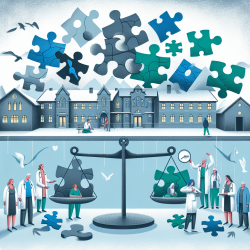Introduction
In the realm of speech-language pathology, creating optimal outcomes for children requires a multifaceted approach. The integration of urban health insights, particularly through the lens of the Sustainable Development Goals (SDGs), offers a promising pathway. This blog delves into the research findings from "Urban health: an example of a 'health in all policies' approach in the context of SDGs implementation," highlighting how practitioners can leverage these insights to enhance their practice and advocate for comprehensive health policies.
Understanding the Health in All Policies (HiAP) Approach
The HiAP approach is a strategic framework that emphasizes the consideration of health implications across all sectors of public policy. By systematically integrating health considerations into decision-making processes, HiAP seeks to improve population health and health equity. This approach is particularly relevant in urban settings, where intersectoral collaboration can drive significant improvements in health outcomes.
Key Findings from the Research
The research conducted by Ramirez-Rubio et al. underscores the importance of using scientific evidence and evaluation tools, such as Health Impact Assessments (HIAs), to inform urban policy decisions. HIAs provide valuable data on the quantitative burden of disease and the economic impacts of health interventions, enabling policymakers to make informed decisions that prioritize health outcomes.
- At least 38 SDG targets are relevant to urban health, spanning 15 SDGs.
- Key aspects such as physical activity, noise, quality of life, and social capital are not fully addressed within the current SDG framework, highlighting the need for a more comprehensive HiAP vision.
- Intersectoral work, policy coherence, health governance, and stakeholder participation are critical for advancing the SDGs.
Practical Applications for Practitioners
For practitioners in speech-language pathology, these findings offer actionable insights:
- Advocate for Comprehensive Policies: Use the data from HIAs to advocate for policies that address the broader determinants of health, such as access to green spaces and safe transportation, which can indirectly impact children's communication development.
- Engage in Intersectoral Collaboration: Partner with urban planners, educators, and healthcare providers to create environments that support holistic child development.
- Focus on Health Equity: Prioritize interventions that address health disparities, ensuring that all children, regardless of socioeconomic status, have access to supportive environments.
Encouraging Further Research
While the current research provides a robust framework, there is a need for continued exploration into the specific impacts of urban health policies on child development. Practitioners are encouraged to engage in research initiatives that explore the intersection of urban planning and speech-language pathology, contributing to a growing body of evidence that supports data-driven decision-making.
Conclusion
By embracing the principles of HiAP and leveraging the insights from urban health research, practitioners can play a pivotal role in shaping policies that foster healthier, more equitable environments for children. This approach not only enhances individual outcomes but also contributes to the broader goal of sustainable development.
To read the original research paper, please follow this link: Urban health: an example of a “health in all policies” approach in the context of SDGs implementation.










